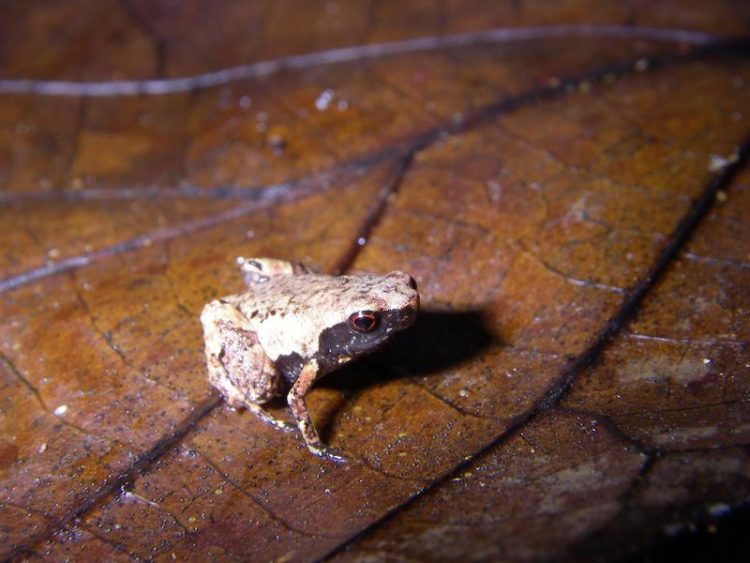Five tiny new frogs discovered in Madagascar

Mini mum lives in the leaf litter in the fragmented lowland forest along Madagascar’s east coast. Photo by Dr Andolalao Rakotoarison
Madagascar, an island a little larger than mainland France, has more than 350 frog species. This number is constantly rising, and many of the newly named species are very small.
The five new species belong to the group of frogs commonly referred to as ‘narrow-mouthed’ frogs, a highly diverse family found on every continent except Antarctica and Europe. Although most narrow-mouthed frogs are small to moderately large, many are tiny, including the smallest frog in the world, Paedophryne amauensis from Papua New Guinea at just 7.7 mm adult body size.
What’s remarkable is that the smallest frogs have evolved to become tiny independently, often several times within a single region, as highlighted in this new study.
Three of the new species belong to a group that is wholly new to science, which the authors have formally dubbed Mini. The other two new species, Rhombophryne proportionalis and Anodonthyla eximia, are also just 11–12 mm, and are much smaller than their closest relatives.
‘When frogs evolve small body size, they start to look remarkably similar, so it is easy to underestimate how diverse they really are,’ says Mark D. Scherz, PhD candidate at the Ludwig Maximilian University of Munich and Technical University of Braunschweig, and lead author on the new study, ‘Our new genus name, Mini, says it all: adults of the two smallest species Mini mum and Mini scule, are 8–11 mm, and even the largest member of the genus, Mini ature, at 15 mm, could sit on your thumbnail with room to spare.’
Finding tiny frogs in the leaf litter is hard work. ‘Calling males often sit one or two leaves deep and stop calling at the slightest disturbance,’ says Dr. Frank Glaw, head of the Section of Herpetology at the Bavarian State Collection of Zoology in Munich (SNSB-ZSM) and senior author on the study, ‘It can take a lot of patience to find the frog you are looking for.’
Cyclones which often batter Madagascar’s eastern coast in the December–March rainy season, can make searching even more difficult. ‘I found Anodonthyla eximia in the early morning after a terrible night, when a cyclone swept away most of our camp,’ says Professor Miguel Vences, head of the Division of Evolutionary Biology at the Technical University of Braunschweig and one of the study’s senior authors. ‘Miserable conditions for biologists can make great conditions for frogs’.
Mark D. Scherz, MSc
LMU München
Münchhausenstraße 21, 81247 München
Tel.: 089/8107112
E-Mail: mark.scherz@gmail.com
Dr. Frank Glaw
SNSB – Zoologische Staatssammlung München
Münchhausenstraße 21, 81247 München
E-Mail: glaw@snsb.de
Scherz MD, Hutter CR, Rakotoarison A, Riemann JC, Rödel M-O, Ndriantsoa SH, Glos J, Hyde Roberts S, Crottini A, Vences M, Glaw F (in press) Morphological and ecological convergence at the lower size limit for vertebrates highlighted by five new miniaturised microhylid frog species from three different Madagascan genera. PLoS One doi:10.1371/journal.pone.0213314
http://journals.plos.org/plosone/article?id=10.1371/journal.pone.0213314
http://www.snsb.de Staatliche Naturwissenschaftliche Sammlungen Bayerns
http://www.zsm.mwn.de Zoologische Staatssammlung München (SNSB-ZSM)
Media Contact
All latest news from the category: Life Sciences and Chemistry
Articles and reports from the Life Sciences and chemistry area deal with applied and basic research into modern biology, chemistry and human medicine.
Valuable information can be found on a range of life sciences fields including bacteriology, biochemistry, bionics, bioinformatics, biophysics, biotechnology, genetics, geobotany, human biology, marine biology, microbiology, molecular biology, cellular biology, zoology, bioinorganic chemistry, microchemistry and environmental chemistry.
Newest articles

Silicon Carbide Innovation Alliance to drive industrial-scale semiconductor work
Known for its ability to withstand extreme environments and high voltages, silicon carbide (SiC) is a semiconducting material made up of silicon and carbon atoms arranged into crystals that is…

New SPECT/CT technique shows impressive biomarker identification
…offers increased access for prostate cancer patients. A novel SPECT/CT acquisition method can accurately detect radiopharmaceutical biodistribution in a convenient manner for prostate cancer patients, opening the door for more…

How 3D printers can give robots a soft touch
Soft skin coverings and touch sensors have emerged as a promising feature for robots that are both safer and more intuitive for human interaction, but they are expensive and difficult…





















